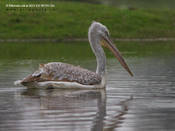search
Мастера на PROFI.RU:
| Ремонт квартир |
| Уборка квартир |
| Мастера по маникюру |
classification:
Gaviiformes
Podicipediformes
Pelecaniformes
Ciconiiformes
Phoenicopteriformes
Anseriformes
Falconiformes
Galliformes
Gruiformes
Charadriiformes
Pterocletiformes
Columbiformes
Cuculiformes
Strigiformes
Caprimulgiformes
Apodiformes
Coraciiformes
Upupiformes
Piciformes
Passeriformes
|
basic information
|
Dalmatian Pelican
Pelecanus crispus (Bruch, 1832)

|
 breeding
|
|
|
2015-04-04
Sorbulak. |
© Askar Isabekov
|
|

Distribution
Inhabits Balkhash-Alakol depression, Kurgaldzhin lakes, lower Turgay river and lakes of the Naurzum Reserve (Teniz and Karakamysh lakes of the Tobol river valley), in 2003 colony existed on Sarykopa lake. After the 1960s nesting resumed on Zaysan lake, where colonies observed in 1980, 1985, 1989 and 1990. In recent years (from 1969) nested on Kamysh-Samar lakes and Dongulyuk Reservoir on Kushum in Volga-Ural region. In 1986-1989 nested in delta of Ural river and Zaburunskiy Gulf. In the 1980s small colonies were found on Akchatau lake in an area adjacent to the east of the Aral Sea and on Chushkakol lakes. Since 1990s yearly nesting observed on Sorbulak lake near Almaty (in 2000 ca. three hundred pairs). On migration and as a vagrant may occur anywhere, including Northern Kazakhstan and in the foothills of the Western Tien Shan, where 17 birds observed 29 September 2004. In 18 –21 December 2003 nine birds recorded on Chardara reservoir.
Biology
Rare breeding migrant. Inhabits large and average sized reservoirs with fish stocks and suitable nesting islands with or without surface vegetation. Arrives at end February – early April in small groups of 5-10 birds, sometimes singly or occasionally in large flocks of up to 100. Colonies are formed soon thereafter and nests constructed on clumps of dry reed, or on stony and sandy islands with no vegetation. Nests are especially large, up to 1.5 m in diameter and up to 1 m in height and are constructed from twigs, reed stems and dry herbaceous drift collected from water’s edge; inner cup lined with thin grass. Both parents build nest. Settles in single pairs or in small colonies (3-20, very rare up to 150-200 pairs), frequently together with White Pelicans and Cormorants. The breeding cycle of each pair tends not to be synchronised. In the colonies juveniles of different ages and clutches at different stages of brooding can be recorded on a single visit. Clutches of 2-4, occasionally of 5-6 eggs, recorded in early April - early July. Both parents incubate for 30-40 days and continue to bring material to nest over the first 7-12 days. In the Ile river delta late summer nesting has been recorded. Juveniles observed end May – August. In autumn birds disperse and fly considerably to the north of breeding sites. Autumn migration late, from mid-October – end November, and odd birds linger to mid-December.
References
"Птицы Казахстана" том 1. "Наука". Алма-Ата, 1960. Gavrilov E. I., Gavrilov A. E. "The Birds of Kazakhstan". Almaty, 2005. Э.И.Гаврилов. "Фауна и распространение птиц Казахстана". Алматы, 1999. В.К.Рябицев. "Птицы Урала, Приуралья и Западной Сибири". Екатеринбург. Изд-во Уральского университета, 2000.


















